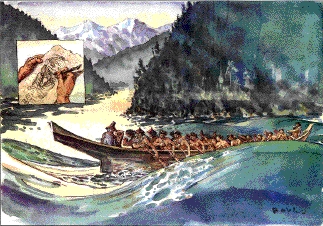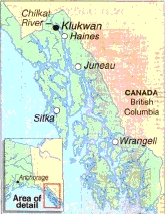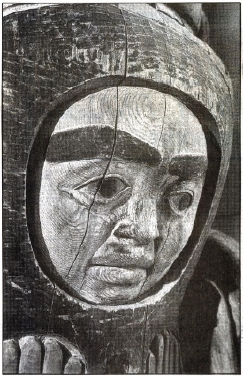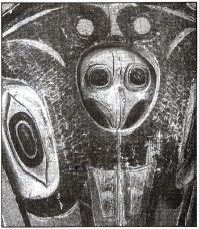Permission has been granted for one-time use only, for the
purpose of website posting.
Courtesy of the Anchorage Daily News
No other reproductions and/or Anchorage Daily News materials are authorized.
The Alaska Federation of Natives has been given republication permission to reproduce the following Anchorage Daily News photos and articles from the Whale House Series:
Series At A Glance
Part 1: The sale of the Whale House legacy.
Part 2: Carving the masterworks.
Part 3: A Tlingit buyer of Tlingit artifacts.
Part 4: A dealer's passion for the Whale House.
Part 5: Epic sage becomes litigation.
MASTER CARVER
Modern-day carvers and anthropologists follow the trail of a Tlingit artist of profound skill and vision
By Marilee Enge

Steve Brown is now the assistant curator of Native American art at the Seattle
Art Museum.
In 1984 he and two other carvers copied the work of Kadjisdu.axtc
Photo by Fran Durner
Second of five parts
An artist named Steve Brown traveled to Wrangell in 1984 to begin the project of a lifetime. He'd been hired to replicate the work of a Tlingit master who lived at least 200 years earlier and created the totems that stood in the nobleman's house in a village that no longer exists.
Brown, a white carver, was intrigued by the Tlingit artist, whose work was distinct but whose identity was unknown. For the next year and a half, he and two other carvers lived close to the land, as they believed that the ancient master would have done. They made their own tools, caught fish and hunted deer.

“Carvers #1” dated 4/4/93. Photo
by Bob Hallinen
Carver John Hagen works on a clam figure on a totem pole at Alaska Indian
Arts, Inc., in Haines.
Hagen and Wayne Price sometimes carve together there.
They worked to create house posts that closely resembled the ones that stood in the house of Chief Shakes, an important Tlingit leader from the old village of Kasitlaan near present-day Wrangell. They cut cool handles from wild crab apple wood and made metal adzes small enough to mimic the ancient artist's fine cuts.
Carvers, anthropologists follow the old Tlingit master and learn to wonder at his genius and the purpose of the Whale House work
They traveled the southern islands of the southeast Panhandle in search of the finest red cedar. And they addressed the spirit of the chosen tree, enlisting its help in the project before cutting it down.

DEE BOYLES/Anchorage Daily News
Mysterious things happened. They discovered that their measurements on one side of the last totem were a half-inch off, lending a lopsided appearance to the shoulders. It seemed like a disaster, until they found that the original had the same flaw.
When the totem was complete and drying, the wood began to crack in the same places as the original.
"We had quite a few coincidences that made us feel like we were in the company of the old man," said Brown.
The old man had done other great carvings on the coast. A beautiful lost totems that appears in photographs from the last century matched his style. So did the famous houseposts in the Whale House of Klukwan.
But the old man had no name.
GREATEST CARVER IN HISTORY
Then, in 1987, a museum curator in Juneau found an early manuscript containing the story of the Whale House carver. It pulled together what Brown and other scholars already suspected about the master.
In his time, he was known as the greatest carver of wood in the history of the Tlingits. He had worked for the Haidas, the Tlingit enemies to the south, and his reputation reached an important leader in the Chilkat territory who planned a grand house in Klukwan to reunite his clan.

“Carvers #2” dated 4/4/93 By: Bob Hallinen
Tlingit carver Wayne Price, who with Steve Brown copied houseposts in Wrangell
originally done by Tlingit master Kadjisdu.axtc.
The artists name, as spelled by linguists interpreting the Tlingit tongue, was Kadjisdu.axtc - "Kad-jis-too-ach."
Little is known of his life, except that he may have been a nobleman himself. Historians can only speculate about the date of the Whale House carvings and the artist's age when he created them. He lived in the village of Kasitlaan, commonly called Old Wrangell, where he had carved the interior corner posts for Chief Shakes' house.
Some time in the early 1800s, a prominent leader from Klukwan named Xetsuwu ("Het-su-wu") resolved to build a large house, a sort of capitol, for his clan, Ganaxteidi. Xetsuwu was "a leader and innovator" of his time, said Chuck Smythe, an anthropologist who has studied the genealogy and clan history of the Ganaxteidi.

“Anthropologist Smythe” dated 4/5/93 By: Bob
Hallinen
Anthropologist Chuck Smythe stands on the main street in Klukwan with the Raven
House (left) and the Whale House in the background.
The clan traced its roots to the earliest people who migrated into southeast Alaska from British Columbia. They lived near the village of Klawock on Prince of Wales Island, but legend has it that a tragic event involving a chief's daughter and a woodworm created such turmoil in their community that they left the place and traveled north.
Tlingit people are divided into two sides, which anthropologists call moieties, represented by the Raven and the Eagle. Marriage had to be with a member of the opposite side for it was considered incestuous to have a Raven marry a Raven. Ravens and Eagles are further divided into clans, like the Ganaxteidi. In traditional times there was one clan to a village. They were political units where decisions were made that affected the whole group.
Clan subdivided again into houses - extended families related through their mothers and wives. Tlingit society is matrilineal: children are born into their mother's clan and house, and the boys moved in with their maternal uncles at the age of 8 or 10. Each house was led by a hitsaati, the keeper or owner of the house. He is now often called the chief.
CLAN BEGINS TO ERODE
The Ganaxteidi was Klukwan's oldest and most prestigious clan, but by the early 1800s some of its leading families had married below their class and Xetsuwu believed the social order was in danger. So he decided to unite them in a great house, under an old crest associated with the Ganaxteidi: the Whale.
"The Whale House was conceived as a kind of council house," said Smythe. "It became very successful and became the lead house in the village up until the turn of the century."
 Today, details of the planning of Xetsuwu's
great house are known because of the field work of ethnographer Louis Shotridge,
a Tlingit who was born and raised in Klukwan. Shotridge left home
to work for the University Museum in Philadelphia, then returned to collect
artifacts and record oral history. He wrote his account in 1925.
Today, details of the planning of Xetsuwu's
great house are known because of the field work of ethnographer Louis Shotridge,
a Tlingit who was born and raised in Klukwan. Shotridge left home
to work for the University Museum in Philadelphia, then returned to collect
artifacts and record oral history. He wrote his account in 1925.
According to Shotridge, Xetsuwu sent a delegation from Klukwan to Kasitlaan to bring back the famous carver. A clan historian went along to tell the clan's story to Kadjisdu.axtc, and on the return trip the artist worked out his ideas on cottonwood bark.
The group probably traveled in a large, ocean-going canoe that could carry 30 people or more, said Peter Corey, curator of the Sheldon Jackson Museum in Sitka. Such canoes were traded from the Haidas, who lived in the Queen Charlotte Islands and had access to the best red cedar for the large, sturdy boats.
As Brown and the other carvers copied the Shakes house posts, their work carried them back in time and they found the spirit of Kadjisdu.axtc - art, wood, myth and man merged into one.
"He lived 'em," said Wayne Price, a Tlingit carver who worked with Brown. "I'd like to have his dream sometime. He crossed over."
They completed the last totem by working through the night. The work finished, Price sat back and imagined he smelled the woodsmoke of the clan house where the old posts first stood.
"Not a day goes by where I really don't think about the guy - he influenced my work so much," said Price. "I've been there. I crossed over."
Brown, now an assistant curator of Native American art at the Seattle Art Museum, has made a study of Kadjisdu.axtc's work. He said the Whale House posts show so much artistry they must have been created at the end of a brilliant career.
If the Shakes posts were carved about 1775, as Brown believes, the carver must have been at least in his 20s at that time. Many years probably passed before he carved the Whale House posts.
"I think their decades apart," he said.
"You can see a progression through time - an influence of other artists, the evolution an artist will go through by trying to do different things, taking ideas and reworking them. By the time you look at the Whale House pieces, in relation to other Tlingit houseposts, they are very complex."
An early Tlingit scholar, Navy Lt. George Emmons, visited Klukwan in 1885 and later wrote a detailed description of the Whale House. He dated posts at 1835, or earlier, and that year stuck. But that would put the artist in his 70s or 80s and it seems unlikely that an elderly man created such a monumental work. Brown believes they were carved between 1800 and 1820.

“Viewer of houseposts” dated 4/5/93 By: Bob
Hallinen
A viewer examines the houseposts in Chief Shakes House in Wrangell, which are
recarvings of posts done by master Tlingit carver Kadjisdu.axtc, who also did
the Whale House posts in Klukwan.
'MONA LISA'
Unlike most Northwest Coast totems, which are cedar, Kadjisdu.axtc chose spruce for the Whale House posts. Cedar doesn't grow in the northern Panhandle, but more important, he may have preferred the denser, harder spruce, Brown said.
"It would be a little slower, but the firmness of the wood would allow you to get finer details than with cedar."
The four posts are more than 9 feet tall and each one tells a story connected to the clan and its origins. They are intricate mosaics of animal, human and otherworldly creatures that flow from one into the other. Every space has a form or a figure that gives the totems their beauty and enriches their tales.
One post tells of the sea monster Gunakadeit. The creature holds a whale in its mouth. In the whale's tail is the sweet, sad face of a woman.
The totems first achieved wide fame from a series of black and white photographs made in the mid-1890s by two Juneau photographers, Lloyd Winter and E. Percy Pond. What those photos don't show is that the posts are painted in rich colors that are mostly intact. The blue-green has faded but the vermillion, a paint of Chinese or European origin, remains vivid.
Even experts like Brown have trouble explaining their beauty and power.
"It's like saying, 'What's special about the Mona Lisa?'" said Brown.
"Whenever it is that defines genius in sculpture, whether you're talking about individual artists in ancient China or Europe or Greece or in the Northwest Coast, whatever distinguishes sculpture and genius imbues their work with a kind of life that is greater than the object itself.
"Few have tied it all together in such a cohesive, effortless-looking whole than this artist."
Kadjisdu.axtc lived in Klukwan for a year, working on the Whale House posts, and he likely carved other pieces while he was there. Emmons said the carver was paid 10 slaves, 50 dressed moose skins and a number of blankets.
CLAN UNITED BEGIN
The four posts represented the four main groups brought together under the Whale House. At the potlatch to dedicate the house, Xetsuwu positioned the four head men at each post.
Xetsuwu 's grand plan succeeded. The newly unified Ganaxteidi clan, and the Chilkats in general, became an important and powerful people, Smyth said. They amassed great wealth, grew to be populous, and bought off white traders. The Whale House was their center, home to Xetsuwu and the chiefs who followed.
In 1852, a Chilkat chief named Chartrich lead a party 300 miles into British territory, where they captured and burned a Hudson's Bay Co. post and warned the intruders to stay out of their established trade zone.
 WINTER & POND
COLLECTION/Alaska
State Library
WINTER & POND
COLLECTION/Alaska
State Library
Yeilgooxu, or George Shotridge, wears a nose ring and holds
a raven rattle in this
1895
photograph. He was the keeper of the Whale House in the early 1900s.
The Chilkat had a distinct advantage over other Tlingits because they lived just beyond open water, on the banks of a river that brought food to their doorstep. They could stay in their main villages year round, rather than move to fish camps in the summer, so they were able to establish permanent homes and communities.
"Had the Chilkat been able to work stone instead of wood, their country would now be the archeological wonder of the Pacific Coast," Emmons wrote.
When he first visited Klukwan in 1885, Emmons said the Whale House was "in the last stages of decay and uninhabitable." The wooden long house had reached the end of its life and was due to be replaced. But most of its art was still in good condition and the house was used for ceremonies. It isn't known where the leading Ganaxteidi families were living, but they probably had moved into more modern houses.
In 1899, the old Whale House and the Raven House next door were torn down and work began on new houses of milled timber. Under the leadership of Yeilgooxu ("Yel-goo-hu"), the reigning Whale House hitsaati, the Ganaxteidi gave a big potlatch invited an important Eagle clan from Sitka. The party went on for several days and more than $10,000 in food, gifts and money were given away, Emmons reported.
Yeilgooxu , whose English name was George Shotridge, was the son of Chief Chartrich. He died not long after the great potlatch and the Whale House was never finished. It was destroyed in a mudslide in 1913 and the carvings were rescued and stored outside under a tarp.
But they were not forgotten. Collectors began combing the Northwest Coast for fine examples of Native art in the late 1800s, and the Whale House artifacts were among the most desirable. The collector who sought the most aggressively was none other than Yeilgooxu's son, Louis Shotridge.

copyright © A. de Menil
A face within a face stares out from the eye of the Sea Creature, the main
personage in this housepost.
The Sea Creature Post
Gunakadeit Gass
 copyright © A. de Menil The face of a woman, Stax-adi, stares out of the whale's tail. |
 copyright © A. de Menil The Sea Creature housepost stood to the right of the entry. |
 copyright © A. de Menil Raven looks out of the blow hole of the whale which has been captured by the Sea Creature. |
This 9-foot-tall housepost, one of four from the Whale House, represents an episode from the adventures of Raven and the sea creature Gunakadeit. Gunakadeit is shown on the post as the main figure holding a whale by its flippers with its tail in his mouth.
The figure of a woman carved on the whale's back represents Stax-adi, included to represent the Yakutat Clan. Inside the round blowhole on the whale's head we see the face of Raven.
Also shown at the top of the post is Gunakadeit Yadi, Gunakadeit‘s child, who is holding the head of a hawk in its paws. The hawk is shown as a crest symbol of the clan while the carving of Gunakadeit Yadi represents the legend of the Daughters of the Creek. This legend states that Gunakadeit's daughters became the Old Women who lived at the head of every stream and are responsible for the yearly return of the salmon.
THE TOTEMS: This is the first of four detailed looks at the houseposts of the Klukwan Whale House.
Photographs
by
Adelaide de Menil
WHO'S WHO Part Two
STEVE BROWN: Modern carver; assistant curator Native American art, Seattle Art Museum.
CHARTRICH: Klukwan chief who raided a Hudson's Bay Post.
LT. GEORGE EMMONS: Naval officer who first visited Klukwan in 1885 and wrote a detailed account of the Whale House.
KADJISDU.AXTC: Tlingit master carver.
WAYNE PRICE: Tlingit carver who worked with Brown.
CHIEF SHAKES: Tlingit leader from Old Wrangell.
LOUIS SHOTRIDGE: Tlingit from Klukwan; collected artifacts for the University of Pennsylvania's University Museum.
CHUCK'S SMYTHE: Anthropologist hired by village of Klukwan to document the genealogy and clan history of the Ganaxteidi.
XETSUWU: Leader in the Ganaxteidi clan; built first Whale House.